Abbeycwmhir is a village situated in the valley of the Nant Clywedog, about four miles ENE of Rhayader. The village is named after its 12th Century Cistercian Abbey, which was tied to Whitland Abbey and was destroyed by the forces of Owain Glyndŵr in 1401. Llywelyn ap Gruffudd, the last native Prince of Wales, is buried there.
The village church is dedicated to St Mary and was rebuilt by Mary Beatrice Philips in 1866. Inside the Church is a bronze war memorial plaque, which commemorates the six local men who fell during the Great War. I have also taken the liberty of adding the details of five men men from the village, including three brothers, and a Portuguese labourer buried there who are not commemorated on the war memorial.
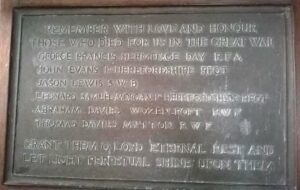
The Great War, 1914-1918
Jacinta Da Costa, Labourer, Portuguese Foresters Corps. Jacinta was a Portuguese ‘trabalhador’ or labourer, who came to Britain to work with the Portuguese Forestry Corps. He was among fifty men of his unit sent to fell trees on the estate of Major Philips. Jacinta became ill and died in the camp on 5 December 1918. He is buried to the north-west of St. Mary’s Churchyard, at Abbeycwmhir. He is not commemorated on the Abbeycwmhir war memorial.
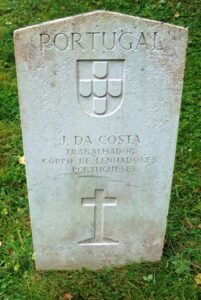
George Francis Hermitage Day, Second Lieutenant, Royal Field Artillery. George was born at Abbeycwmhir in 1895, the son of Reverend Ernest Hermitage Day and Mrs Doris Elinor Day (nee Philips). He was commissioned into the Royal Field Artillery in February 1916 and was posted to the 125th Battery, Royal Field Artillery, which was attached to the 4th Division. George arrived in France soon after being commissioned, joining the battery on the Somme, where it was preparing to take place in the forthcoming Somme offensive, which was launched on 1 July 1916. George was then attached to the 42nd Siege Battery, Royal Garrison Artillery, which was also in the Somme sector. On 10 September 1916 George was working his way into an advanced position, together with his telephonist, Gunner John Leck (66509), when both men went missing. George was officially recorded as being missing, presumed killed in action that day. He was 20 years old and is commemorated on the Thiepval Memorial, France. He is also commemorated on the Rhayader war memorial.
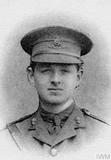
John Evans, Private, 266739, Monmouthshire Regiment. John was born at Hope Bowdler in 1886, the son of Thomas and Mary Evans. On 3 April 1910 he married Alice Ann George, of Cwmgiver Cottage, Abbeycwmhir, where he worked as a waggoner. John enlisted into the Monmouthshire Regiment at Hereford on 11 December 1915 and on 11 June 1916 joined its 2nd Reserve Battalion at Pontypool. He arrived in France on 4 December 1916 and was posted to the 2nd Battalion, Monmouthshire Regiment, which was by then the Pioneer battalion to the 29th Division. The division was by then back on the Somme, near Montauban. The 2nd Monmouths remained in this sector over the winter and by 20 February 1917 had a number of men at work building galvanised iron huts near Hardecourt Camp and more building trench mortar positions at a location called Wedgewood. This work was still continuing on 23 February 1917 when the working party that John was with was caught up in German artillery fire, killing John and two other men in the village of Sailly-Saillisel. John was 33 years old when he died that day, and is buried in Sailly-Saillisel British Cemetery, France.
David Evan Hope, Private, 235774, Herefordshire Regiment. David was born out of wedlock at St. Harmon as David Evans, the son of Eliza Ann Evans. His mother married Aaron Hope in 1894 and the couple set up home at Abbeycwmhir, where two other sons were born. By 1901 the family had moved to Wernddu Cottage, Nantmel and a further three daughters and one other son were born, before the family moved again, to 5, Brookland Road, Llandrindod Wells. David enlisted at Hereford into the Herefordshire Regiment, and was posted to their 1/1st Battalion, which was attached to the 53rd (Welsh) Division. On 16 July 1915 he embarked at Devonport with the battalion, aboard the SS Euripedes, which set course for Port Said. On the morning of 9 August 1915, the battalion landed at ‘C’ beach at Suvla Bay, Gallipoli, taking part in heavy fighting over the coming days. The battalion remained on Gallipoli until being evacuated on 12 December 1915 and moved to Egypt with the division. The division guarded the Suez Canal line for over a year, before taking part in the advance into Palestine, and saw heavy fighting during the First Battle of Gaza on 26 March 1917. David was wounded and taken prisoner during the battle and died in captivity the following day, 27 March 1917, aged 27. He has no known grave and is commemorated on the Jerusalem Memorial, Israel. David is one of three Hope brothers who fell during the war. None of them are commemorated at Abbeycwmhir, but are commemorated together on two memorials at Llandrindod Wells.
Edward Aaron Hope, Corporal, 148131, Machine Gun Corps. Edward was born at Abbeycwmhir in 1897, the son of Aaron and Elizabeth Ann Hope. By 1901 the family had moved to Wernddu Cottage, Nantmel and a further three daughters and one other son were born, before the family moved again, to 5, Brookland Road, Llandrindod Wells. He enlisted at Knighton into the Herefordshire Regiment but, unlike his two brothers, was posted to France, joining the 38th Battalion, Machine Gun Corps, which was attached to the 38th (Welsh) Division. He probably joined up with the division after its assault on Mametz Wood in July 1916 and possibly took part in the divisions assault on the Pilckem Ridge, during the opening of the Third Battle of Ypres, on 31 July 1917. The division wintered in the Armentieres sector, before being moved to positions north of Albert, on the Somme, at the end of March 1918, and remained there until launching their offensive across the flooded Ancre valley on 21 August 1918. Edward would have been a member of a machine-gun crew covering the river crossings, which the assaulting troops waded through during the opening of the offensive that morning. Edward was killed in action on the following day, 22 August 1918, whilst more troops were crossing the Ancre. He was 21 years old and is buried in Varennes Military Cemetery, France. Edward is one of three Hope brothers who fell during the war. None of them are commemorated at Abbeycwmhir, but are commemorated together on two memorials at Llandrindod Wells.
John Hope, Private, 236726, Herefordshire Regiment. John was born in Abbeycwmhir in 1894, the son of Aaron and Elizabeth Ann Hope. By 1901 the family had moved to Wernddu Cottage, Nantmel and a further three daughters and one other son were born, before the family moved again, to 5, Brookland Road, Llandrindod Wells. He enlisted at Llandrindod Wells into the Herefordshire Regiment, and was posted to their 1/1st Battalion, which was attached to the 53rd (Welsh) Division. On 16 July 1915 he embarked at Devonport with the battalion, aboard the SS Euripedes, which set course for Port Said. On the morning of 9 August 1915, the battalion landed at ‘C’ beach at Suvla Bay, Gallipoli, taking part in heavy fighting over the coming days. The battalion remained on Gallipoli until being evacuated on 12 December 1915 and moved to Egypt with the division. The division guarded the Suez Canal line for over a year, before taking part in the advance into Palestine. John took ill and died in hospital at Kantara on 7 March 1917, aged 22. He is buried in Kantara War Memorial Cemetery, Egypt. John is one of three Hope brothers who fell during the war. None of them are commemorated at Abbeycwmhir, but are commemorated together on two memorials at Llandrindod Wells.
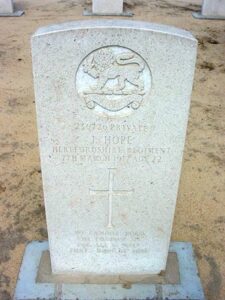
David Noel Jones, Private, 2009, Welsh Regiment. David was born at Abbeycwmhir in 1890, the son of John George and Matilda Jones. He resided at Pontarddulais prior to the war, and enlisted at Swansea into the 1/6th Battalion, Welsh Regiment. The battalion landed in France on 29 October 1914, and moved to work on Lines of Communication around Calais. On 5 July 1915 it became attached to 84 Brigade, 28th Division, and on 23 October 1915 transferred to 3 Brigade, 1st Division. The Division was at Loos, and it was here on 22 November 1915 that David was killed. He was 25 years old and is buried in Dud Corner Cemetery, Loos, France. David is not commemorated on the Abbeycwmhir war memorial, but at Newbridge-on-Wye.
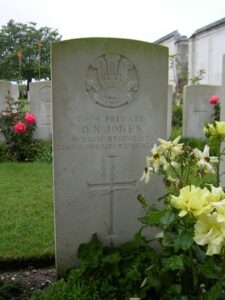
Richard Bertram Jones, Private, 21184, Royal Welsh Fusiliers. Richard was born at Tryddyn, Flint in 1897, the son of Richard and Susannah Jones. By 1901 the family had moved to Abbeycwmhir, where his father had gained a position as head gamekeeper on the Cwmhir estate. The family lived there for over ten years, and Richard and his siblings were educated there, before his father retired just prior to the war and moved the family to 8, Ritson Street, Briton Ferry. Richard enlisted at Neath into the 14th Battalion, Royal Welsh Fusiliers, which was raised as part of the newly formed Welsh Division and trained in north Wales before the division was re-numbered to the 38th (Welsh) Division. On 2 December 1915 Richard embarked for France with his battalion, and the entire division assembled in northern France, near Festubert, where it was initiated into trench warfare. After several months in different sectors in northern France the division marched south to the Somme at the end of June 1916 to take part in the great offensive there, and from 7 July 1916 began to assault Mametz Wood. The first assault failed, but the division re-organised, under a different Commander, as its original Commander, Sir Ivor Philipps had been sacked, and attacked again on 10 July. Following two days of hand-to-hand fighting the wood was cleared and the division withdrew to Hébuterne to rebuild before taking over the canal bank sector north of Ypres, at Boesinghe. In the meantime, Richard had been attached to a Tunnelling Company of the Royal Engineers and was at work in the Festubert area when he was killed on 13 September 1916, aged 19. He is buried in Gorre British and Indian Cemetery, France. Richard is not commemorated on the Abbeycwmhir war memorial.
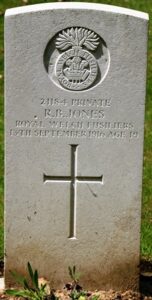
Jason Lewis, Private, 15436, South Wales Borderers. Jason was the son of Thomas and Elizabeth Lewis, of Abbeycwmhir. He worked as a gardener for Doctor John Jones at Clydach prior to the war and in August 1914 attested into the South Wales Borderers. He was not called up straight away, so moved to 25 Cheltenham Road, Greaves, Lancaster after gaining another job, and married Annie Huck in 1915, just before being called up, and joined the 7th Battalion, South Wales Borderers, which was attached to 67 Brigade, 22nd Division. The Division moved to France in early September 1915, and only spent a short period at the front before entraining for Marseilles, where it embarked for Salonika on 27 October 1915. The campaign in Salonika was difficult, as the Allies gained no real success in their campaign against the Bulgarians. The 22nd Division took part in the Retreat from Serbia during December 1915 and fought in several battles: Horseshoe Hill; Machukovo; and the three battles of Doiran. The last major action was during the Third Battle of Doiran, which was launched on 18 September 1918. Jason was killed in action during the fighting that day. He was 37 years old and is commemorated on the Doiran Memorial, Greece. An armistice with Bulgaria was signed on 30 September 1918. Jason is commemorated on at least four known war memorials: at Abbeycwmhir, Pontardawe, Rhayader, and Lancaster. His widow later lived at 16, Wellington Road, Bowerham, Lancaster, with their two children, one from a previous marriage.
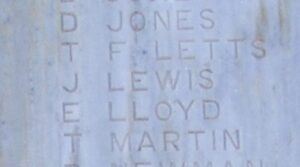
Leonard Samuel Morgan, Private, 238945, Herefordshire Regiment. Leonard was the son of Samuel and Mary Morgan, of Mill House, Abbeycwmhir. He enlisted locally into the Herefordshire Regiment and was posted to the 1st Reserve Battalion, Herefordshire Regiment at Oswestry. Leonard became ill and died at Oswestry Hospital on 16 February 1917, aged 19. His remains were brought home for burial in St. Mary’s Churchyard, Abbeycwmhir. The inscription on his grave reads: ‘PEACE PERFECT PEACE’.
Thomas Davies Mytton, Private, 55484, Royal Welsh Fusiliers. Thomas was born at Knighton in 1892, the son of Richard and Alice Mytton. His father was from Abbeycwmhir and just after the turn of the century the family moved back to Cwmhir Cottage, Abbeycwmhir. Thomas worked as a waggoner at a farm at Clun prior to the war and was a Territorial soldier, having enlisted at Rhayader into the Montgomeryshire Yeomanry some years prior to the war. At some time late in 1916, he was posted to France, joining the 17th Battalion, Royal Welsh Fusiliers, which was attached to the 38th (Welsh) Division. The division had just been withdrawn from the Somme sector after its mauling at Mametz Wood, and took up the canal bank line north of Ypres, near Boesinghe, where it remained for the next year before taking part in the opening assault of the Third Battle of Ypres, capturing Pilckem Ridge on 31 July 1917. After wintering in the Armentieres area, the division moved south to positions north of Albert, where it took up the line facing across the Ancre valley, facing Thiepval Ridge. Thomas was killed by artillery fire near Mesnil while attached to the 115th Trench Mortar Battery on 9 June 1918, aged 26. He is buried in Mesnil Communal Cemetery Extension, France.
Abraham Davies Wozencraft, Private, 424258, Canadian Infantry. Abraham was born on 22 May 1880, the son of William and Jane Wozencraft, of Abbeycwmhir. He was a farmer who emigrated to Canada in 1905, where he set up his own farm. Abraham enlisted at Portage la Prairie on 4 March 1915 into the 45th Overseas Battalion, Canadian Infantry and embarked with the battalion aboard the SS Missanabie for England in February 1916. He arrived at Le Havre on 2 March 1916 and was drafted to the 28th (North West) Battalion, Canadian Infantry, which was attached to the 2nd Canadian Division. Abraham’s first major action came when the 2nd Canadian Division took over the line at the hotly contested St. Eloi craters on the night of 3 April and two days later were hit by a German attack, and saw heavy fighting in the heavily cratered ground. The 28th Battalion counter-attacked in conjunction with two other battalions on the following day but failed to regain any of the lost craters before being withdrawn. The fighting continued over the coming weeks while the Germans contemplated their next move. The Canadians held the high ground at Mount Sorrel, Hill 62 and Hill 60, and on the morning of 2 June 1916 launched a fierce attack, under cover of an artillery barrage, upon the Canadians. A counter-attack on the following day failed, and three days later the Germans struck another blow and exploded four mines under the Canadian lines, before capturing the remains of Hooge. Abraham was posted as missing during that terrible day, on 6 June 1916. He was later officially deemed as having been killed in action on that date. He was 36 years old and is commemorated on the Menin Gate Memorial, Ypres.